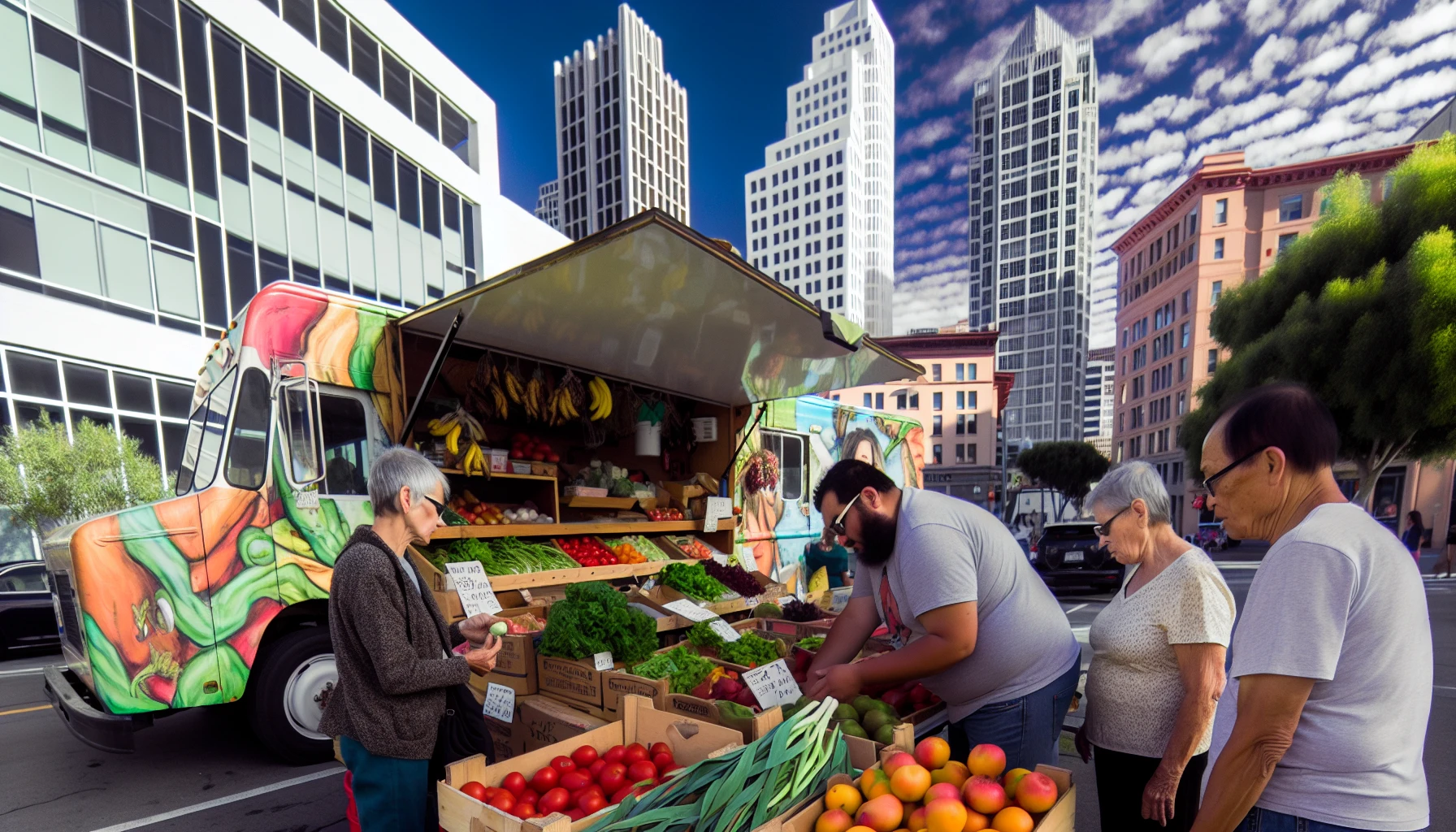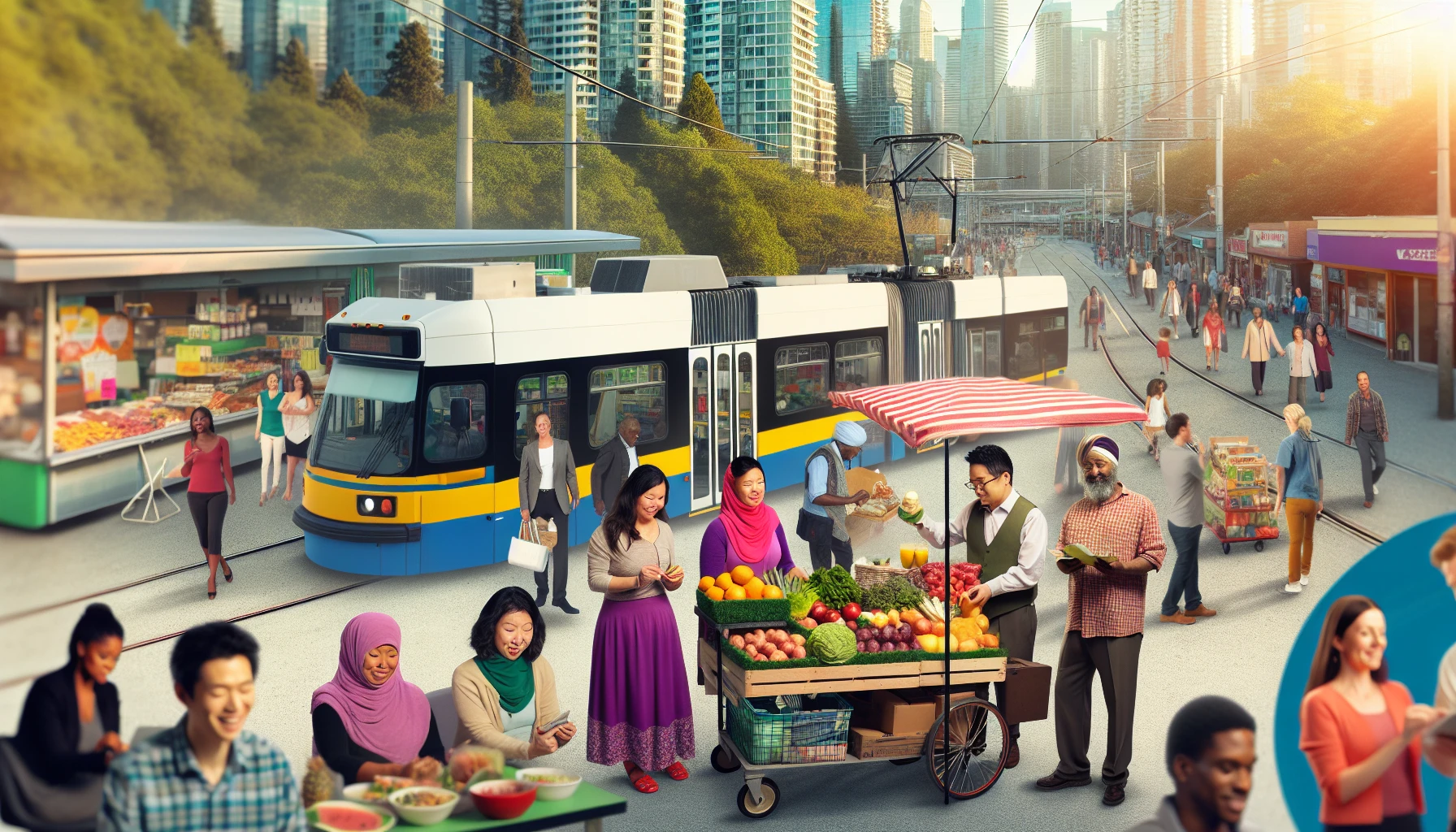Imagine living in a neighborhood where access to affordable, nutritious food is a distant dream. For millions of people residing in food deserts, this is a harsh reality. Addressing this pressing issue requires innovative solutions for food deserts, policy changes, and community involvement. In this blog post, we will explore various approaches to bridge the nutrition gap in underserved communities and promote equitable food access.
Key Takeaways
Food deserts are areas with limited access to healthy foods, resulting in negative health consequences.
Transportation and racial/socioeconomic factors contribute significantly to food insecurity in underserved communities.
Innovative grocery store models, small-format stores, mobile markets, community cooperatives & farmers markets can help bridge the nutrition gap while policy solutions like tax incentives & nutrition assistance programs provide Support.
Understanding Food Deserts

Food deserts are areas with restricted access to reasonably priced and nutritious healthy foods, typically characterized by an abundance of fast food restaurants and a lack of grocery stores. Factors such as food insecurity, social determinants of health, racial residential segregation, and inadequate access to transportation contribute to the existence of food deserts. Living in a food desert can result in poor health outcomes, including obesity, diabetes, heart disease, and vitamin deficiencies.
Potential solutions to food deserts include:
Innovative grocery store models
Farmers markets
Urban farming initiatives
Policy and program solutions
Grassroots efforts
Community advocacy
Addressing the root causes of food deserts can result in improved food access and healthier outcomes for underserved communities.
The Role of Transportation
Transportation plays a significant role in food deserts, as limited access to public transit or personal vehicles can hinder access to fresh food sources and nearby grocery stores. Neighborhoods without access to a vehicle are often situated farther away from grocery stores, making it difficult for residents to obtain fresh produce and other healthy food options. Consequently, the lack of transportation can exacerbate the prevalence of food deserts in low-income communities.
Collaboration with small grocery stores, like tiendas, could serve as a practical method to alleviate the issues of food deserts. However, acculturation plays a role in fruit and vegetable intake among Latinos, as individuals who have been in the United States for a longer period tend to consume fewer fruits and vegetables.
Racial and Socioeconomic Factors
Racial and socioeconomic factors contribute to the prevalence of food deserts, with low-income Black and Latino populations disproportionately affected. Some statistics include:
About 20% of Black households live in food deserts.
Lack of access to adequate food in lower-income neighborhoods is 2.5 times greater than the national average.
Minority populations must travel a considerably longer distance to access nutritious foods than white populations.
Food insecurity rates among Black and Hispanic households are significantly higher than the national average, with 19.1% of Black households and 34.9% of households with incomes below the poverty line experiencing food insecurity. Tackling these racial and socioeconomic disparities is a key step towards promoting fair food access and enhancing health outcomes in food deserts.
Innovative Grocery Store Models

Innovative grocery store models, such as small-format stores, mobile markets, and community-owned cooperatives, can help increase food access and bridge the nutrition gap in food deserts. These models offer fresh, healthy food options and support local agriculture while addressing the unique needs of underserved communities. Enhancing the food offerings of existing stores in a community is also a viable solution to improve access to affordable and nutritious food.
Investigating innovative models can lead to increased food access in food deserts and the promotion of healthier communities. We should analyze how small-format stores, mobile markets, and community-owned cooperatives can aid in this endeavor.
Small-Format Stores
Small-format corner stores:
Occupy a smaller square footage compared to traditional large-format stores
Ideal solution for urban areas with limited space and parking
Provide tailored product assortments based on the unique needs of the community
Strategically located to bring brands closer to urban consumers
Generally have higher prices than traditional grocery stores due to increased operating costs and fewer volume discounts
Offer a valuable alternative for residents in food deserts
Small-format convenience stores, acting as local food retailers, typically provide a selection of goods, such as:
fresh and packaged foods
beer and wine
pet food
basic household products
Offering these options in urban food deserts allows small-format stores to enhance access to fresh, healthy food for residents of low income neighborhoods who might otherwise find it challenging to obtain.
Mobile Markets
Mobile markets, or farm stands on wheels, provide fresh fruits, vegetables, and other food staples to neighborhoods lacking access to healthy and affordable food options. These markets address the issue of food deserts by increasing residents’ access to produce in underserved areas while maintaining a smaller footprint, making it easier to reach rural and remote communities.
Mobile markets offer numerous benefits, including:
Economic impact
Increased access to fresh produce
Health promotion
Community engagement
Supporting local producers, invigorating the local economy, and encouraging better health outcomes, mobile markets take on an essential role in addressing food disparities and enhancing the overall quality of life in underserved communities.
Community-Owned Cooperatives
Community-owned cooperatives are businesses that operate primarily for the benefit of their community, with ownership and control held by community members. These cooperatives provide economic benefits, contribute to economic growth, and foster shared rewards and solidarity in rural and remote communities.
Successful examples of community-owned cooperatives in food deserts include the Mandela Co-op in West Oakland, California, and various cooperatively owned grocery stores across the nation. Empowering local residents to control their own food and sources and supporting local economies enables community-owned cooperatives to take a significant role in alleviating food deserts and promoting fair food access.
Farmers Markets and Urban Farming Initiatives

Farmers markets and urban farming initiatives can improve access to fresh, healthy food in food deserts while supporting local agriculture. By offering fresh produce directly to consumers, these initiatives not only address food access issues but also promote community engagement and foster a sense of ownership and pride among residents.
We should investigate how the expansion of farmers markets in low-income areas and the implementation of urban farming initiatives can aid in enhancing food access and fostering healthier communities.
Expanding Farmers Markets in Low-Income Areas
Farmers markets can provide fresh food options in food deserts, offering a potential solution to the challenges faced by low-income communities. However, concerns about farmers markets contributing to gentrification are valid and must be considered when planning their expansion.
Community acceptance plays a significant role in the success of local farmers’ markets, as it ensures that these markets address the needs of the local population and contribute to the overall well-being of the community.
Strategically expanding farmers markets in low-income areas can lead to the provision of affordable and nutritious food options, while encouraging community engagement and cultivating a sense of ownership among residents.
Urban Farming Initiatives
Urban farming initiatives have several benefits, including:
Transforming vacant lots into productive green spaces
Providing fresh produce for residents
Offering educational opportunities
Increasing biodiversity
Preventing the heat island effect
Promoting healthy communities
Improving food security
Enhancing social cohesion in urban areas.
Successful examples of urban farming initiatives in food deserts include the Michigan Urban Farm Initiative, which grow food and provide access to fresh produce in underserved communities. Addressing food insecurity and empowering residents to build social capital allows urban farming initiatives to take a significant role in combating food deserts and promoting fair food access.
Policy and Program Solutions

Policy and program solutions, such as government tax incentives, transit funding, food stamps, and nutrition assistance programs, can help address food deserts. By implementing these strategies, we can support the expansion of grocery stores, farmers markets, and other fresh food sources in underserved areas. In addition, we can improve access to healthy food options for low-income individuals and families, promoting better health outcomes and reducing food insecurity.
We should examine in detail how government tax incentives, transit funding, and nutrition assistance programs can aid in addressing the issue of food deserts.
Government Tax Incentives
Government tax incentives can encourage the establishment of grocery stores and other fresh food sources in underserved areas. Examples of successful government tax incentives for combating food deserts include:
Tax incentives offered for grocery stores built within low-income, low-access areas
The Food Desert Relief Act providing tax breaks to supermarkets and grocery stores in underserved areas
Incentive opportunities for existing grocers and new grocery stores to open in food deserts
These tax incentives can have a considerable impact on the implementation of grocery stores in underserved areas, encouraging grocery and small store owners and operators to invest in these communities and improve access to fresh, healthy food options.
Transit Funding for Improved Access
Transit funding can improve access to fresh food sources by enhancing public transportation options in food deserts. Successful examples of transit funding improving access to fresh food sources include GrowingChange, Community Outreach and Patient Empowerment, and Equitable Public Transit. Investing in transit infrastructure and services enables more individuals in food deserts to easily reach grocery stores and farmers markets, increasing their access to fresh and nutritious food.
Though there are challenges to implementing transit funding for increased access to fresh foods in food deserts, such as limited transportation options, transportation costs, and restricted access to supermarkets, the benefits of enhanced public transportation cannot be overstated.
Nutrition Assistance Programs
Nutrition assistance programs, such as the Supplemental Nutrition Assistance Program (SNAP) and the Women, Infants, and Children (WIC) program, can help low-income individuals and families afford healthy food options. These programs address barriers to accessing healthy food choices and have been shown to decrease food insecurity. In particular, seniors without vehicles and SNAP recipients in food deserts may be especially vulnerable to limited food store access, making these programs crucial for their health.
Providing financial assistance and supporting access to nutritious food options allows nutrition assistance programs to play a key role in addressing food deserts and promoting better health outcomes in underserved communities.
Grassroots Efforts and Community Advocacy

Grassroots efforts and community advocacy can play a crucial role in addressing food deserts and promoting equitable food access. By advocating for policy changes, organizing local initiatives, and encouraging community involvement, we can tackle the root causes of food deserts and promote healthier communities.
We should investigate how community advocacy and local food co-ops can aid in addressing food deserts and enhancing food access in underserved areas.
Community Advocacy
Community advocacy can raise awareness of why food deserts exist and push for policy changes to improve food access in underserved areas. Effective methods of community advocacy for addressing food deserts include:
Community organizing and advocacy
Partnering with transportation advocates
Establishing bus stop farmers markets
Supporting community gardens
Enhancing public transportation options
By advocating for increased funding for grocery stores and farmers markets in underserved areas, backing the creation of community gardens and urban farms, and raising awareness regarding the significance of access to healthy food, community advocates can drive change and build a more equitable food system.
Successful examples of community advocacy against food deserts include the establishment of nonprofit grocery stores, which address the lack of access to healthy and affordable food options in underserved communities.
Local Food Co-ops
Local retail food outlets, co-ops, or grocery stores owned and controlled by the individuals who frequent them, can provide:
Affordable, nutritious food options
A sense of community ownership and empowerment
Improved access to affordable fresh food
Engagement of the community in the process
These co-ops are designed to serve as community food stores, fostering a sense of community ownership and empowerment while improving access to affordable, nutritious food options.
Successful examples of local food co-ops in food desert areas include the Mandela Co-op in West Oakland, California, and various cooperatively owned grocery stores across the nation. Supporting local food co-ops aids in addressing food deserts and promoting fair food access in underserved communities.
Summary
Food deserts present a complex challenge that requires innovative solutions, policy changes, and community involvement. By exploring innovative grocery store models, expanding farmers markets and urban farming initiatives, implementing policy and program solutions, and engaging in grassroots efforts and community advocacy, we can bridge the nutrition gap in underserved food insecure communities and promote equitable food access. Together, we can build a more just and healthy food system for all.
Frequently Asked Questions
Are food deserts a wicked problem?
Food deserts are undoubtedly a wicked problem due to their complex, interconnected, and fluid causes. With huge numbers of people and opinions involved as well as socioeconomic situations at play, resolving this issue is a challenging undertaking.
Why are food deserts an environmental justice issue?
Food deserts are an environmental justice issue as lack of access to affordable, nutritious food has been linked to several debilitating health issues, and food apartheid is ultimately an economic and environmental injustice. Additionally, the dependency caused by food deserts restricts the lives of those within the community and prevents communities from maintaining their independence.
What is a solution to the problem of food deserts?
Government policies and programs such as tax incentives for grocery stores built in low-income areas can help solve the food desert problem. Offering incentives encourages grocers to provide access to fresh, healthy food for communities that need it most.
How can you eliminate food deserts?
We can reduce and eventually eliminate food deserts by taking a community-based approach that includes local markets, community gardens, surplus food sharing programs, federal food assistance programs, and food pantries. Together, these solutions can make healthy, affordable foods available in underserved areas.
How do you solve food insecurity?
Addressing food insecurity requires investing in nutrition assistance programs, increasing benefit amounts, and tackling unemployment. Additionally, reducing food waste, increasing education on food insecurity, diversifying protein sources with healthier foods, and amplifying activism to support vulnerable populations are all important steps to take.



